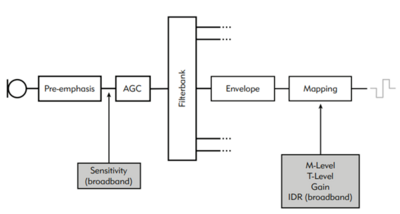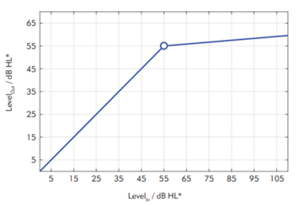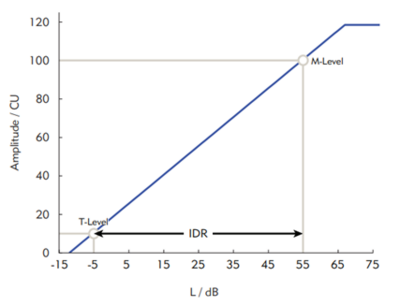Cochlear Implants: Difference between revisions
| Line 80: | Line 80: | ||
*Signal is the signal (Hilbert Envelope) amplitude. | *Signal is the signal (Hilbert Envelope) amplitude. | ||
In principle C1 and C2 are redundant, but in practice they are determined by different parameters as we will see in the example of Advance Bionics. | In principle C1 and C2 are redundant because you could replace K * C1 + C2 by a single constant, but in practice they are determined by different parameters as we will see in the example of Advance Bionics. | ||
In the case of Maplaw mapping when C = 0 it simplifies into a linear relationship: I = K * (Signal + C1) + C2 | In the case of Maplaw mapping when C = 0 it simplifies into a linear relationship: I = K * (Signal + C1) + C2 | ||
Revision as of 11:27, 16 August 2024
Introduction
A hearing aid with a cochlear implants translates incoming sound into electrical signals that are directly stimulating the nerves in the cochlea. The process of converting the sound waves into electrical current is done by a sound processor outside of the ear. The steps are the following:

- Microphone picks up sound
- ADC converts analog signal to digital signal
- Pre-filtering is applied for speech emphasis
- Automatic Gain Control (AGC) is applied
- Signal is split into frequency bands by a filter bank
- Hilbert Envelopes (amplitudes) are calculated per band
- Signal amplitudes per band are mapped to current amplitudes
- Current amplitudes per band are convoluted with spiking patterns
- Current steering distributes the current of a single band over multiple electrodes
- The resulting signals sent to the electrodes
Microphone
% todo sensitivity spectral response
Analog to digital conversion
% todo Sampling rate ADC bit depth Signal representation
Pre-emphasis filter

The pre-emphasis filter is designed to enhance speech recognition by attenuating lower frequencies in sound, which are less critical for understanding speech. This attenuation helps emphasize higher frequencies, where important speech information, like consonant sounds, is more prominent.
As a consequence, the overall loudness of the sound, measured in decibels (dB), is typically reduced after filtering. The degree of loudness reduction depends on both the filter's characteristics and the spectral content of the input sound.
For example, when pink noise is processed through the pre-emphasis filter, as applied in Advanced Bionics (AB) devices, the loudness is reduced by approximately 10 dB. However, when speech is processed, the reduction in loudness is less pronounced due to the different spectral content of speech, which has more energy in the higher frequency bands where the filter has less impact.
Automatic Gain Control

Automatic Gain Control (AGC) in cochlear implants serves two primary purposes:
- It maintains speech levels near the most comfortable listening level for the CI user.
- It rapidly reduces the gain when very loud sounds are detected to prevent discomfort.
The AGC achieves these goals through two processes:
- Averagers (fast and slow): These use buffers to average sound levels over specific time windows. The fast averager responds quickly to sudden changes in sound level, while the slow averager handles more gradual changes. When the average level exceeds a predetermined threshold, often called the kneepoint, the averagers calculate the excess loudness and triggers the compression system.
- Compression: When excess loudness is detected by the averagers, the compression system reduces the gain according to a pre-defined compression function. This function usually applies more compression to louder sounds, effectively narrowing the dynamic range in the output signal and ensuring that softer sounds remain audible while protecting the user from loud sounds.
See Dynamic_range_compression on wikipedia for more background info on compression.
Band filtering
%todo
Hilbert Envelopes
%todo
Spike patterns
%todo
The mapping function

The mapping function translates the Hilbert Envelope Amplitudes for each channel to electrical signal amplitudes.
Different manufactorers use different mapping functions:
| Type of Mapping | Formula | Y(X) | Manufacturer |
|---|---|---|---|
| Logarithmic | I = K * (Y(Signal) + C1) + C2 | Y(X) = log(X) | Advanced Bionics |
| Power Law | I = K * (Y(Signal) + C1) + C2 | Y(X) = Xα | Cochlear |
| Maplaw | I = K * (Y(Signal) + C1) + C2 | Y(X) = ln(1 + C * X)/ln(1 + C) | MED-EL |
- K is a proportionality factor or slope (sometimes incorrectly called 'gain').
- α is the exponent in the power law function
- C is a parameter that determines the curvature of the Y function in the Maplaw case.
- C1, C2 are constants. C1 determines an offset on the horizontal axis. C2 determines an offset on the vertical axis.
- I is the electrical output in current units.
- Signal is the signal (Hilbert Envelope) amplitude.
In principle C1 and C2 are redundant because you could replace K * C1 + C2 by a single constant, but in practice they are determined by different parameters as we will see in the example of Advance Bionics.
In the case of Maplaw mapping when C = 0 it simplifies into a linear relationship: I = K * (Signal + C1) + C2
Sometimes different constants are used below and above the kneepoint.
Example: Advanced Bionics Mapping Function
Following Advanced Bionics we can fill in some details of their mapping function:
K = (M-T)/IDR C1 = - KNEE + IDR + GAIN C2 = T L = 20 * log10(Signal)
resulting in:
I = ((M-T)/IDR) * (L - KNEE + IDR + GAIN) + T
where
- M is the most comfortable level in current units (CU). N.B. Current units are defined differently by different manufacturers.
- T is the threshold level in current units (CU)
- L is the loudness in dB
- KNEE is the kneepoint of the compression function in dB
- IDR is the input dynamic range in dB
- GAIN is the channel gain in dB
It follows from the equation that
L = KNEE - GAIN
results in
I = M
Since the GAIN is set to zero in most cases, it follows that the output is at the M-level when
L = KNEE
Terminology of Critical Points in the Mapping Function
In scientific literature, three key levels are recognized: 1. hearing threshold, 2. comfortable level, and 3. pain threshold, each denoted in various ways.
The following abbreviations are commonly used to describe specific levels of electrical stimulation:
- T, THR, or THL: These stand for Threshold Level, or Threshold Hearing Level. This is the lowest level of electrical stimulation that the user can perceive.
- M, MCL, or C: These abbreviations stand for Most Comfortable Level, Maximum Comfortable Level, or Comfortable Level. This level refers to the point at which sounds are comfortably perceived—neither too loud nor too soft.
- USL, MSL, UCL, or LDL: These stand for Upper Stimulus Level, Maximum Stimulation Level, Uncomfortable Loudness Level, or Loudness Discomfort Level. This level indicates the point at which sound becomes painful or uncomfortable for the user.
The terminology can vary depending on the manufacturer. For example, for the comfort level in clinical software:
- Advanced Bionics uses 'M-level',
- Cochlear uses 'C-level',
- Med-El uses 'MCL'.
There can also be some variation in the precise definitions of these terms.
The term "Maximum Comfortable Level" is less commonly used and can sometimes refer to the highest level that is still comfortable, just below the pain threshold. This usage can be confusing and should be avoided where possible.
Current Steering
%todo